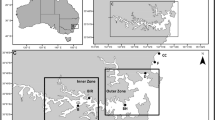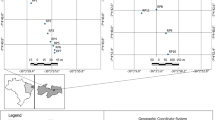Abstract
Ecological and evolutionary processes in temporary rock pools operate within constraints imposed by their hydrologic regimes. These shallow pools flood when seasonal rains accumulate on impermeable substrates. Despite the ecological importance of hydrologic conditions for these ecosystems, we typically lack tools and empirical data required to understand the implications of hydrologic variability and climate change for biotic populations and communities in these habitats. In this study, we developed a hydrologic model to simulate rock pool hydrologic regimes based on rainfall, evapotranspiration, and basin geometry. The model was used to investigate long-term patterns of seasonal and inter-annual variation in hydroregime. In addition, hydrologic conditions associated with potential climate change scenarios were simulated and evaluated with respect to the biological requirements of the anostracan Branchipodopsis wolfi. The model’s output for daily inundation matched with field observations with an overall accuracy of 85% and correctly estimated complete hydroperiods with an overall accuracy of 70%. Simulations indicate large variation in individual hydroperiods (76–115%) as well as in the number of hydroperiods per year (19–23%). Furthermore, this study suggests that climate change may significantly alter the rock pool hydroregime. These findings confirm the hydrologic sensitivity of these ephemeral habitats to precipitation patterns, and their potential sensitivity to future climate change. Modelling indicates that the suitability of average inundation conditions for B. wolfi deteriorates significantly under future climate predictions. High levels of spatial and temporal variation in hydrologic conditions are dominant features of these habitats and an essential consideration for understanding population and community-level ecological processes.


Similar content being viewed by others
References
Andrushchyshyn O, Magnusson AK, Williams DD (2003) Ciliate populations in temporary freshwater ponds: seasonal dynamics and influential factors. Freshw Biol 48: 548–64
Bauder ET (2005) The effect of an unpredictable precipitation regime on vernal pool hydrology. Freshw Biol 50: 2129–35
Bilton DT, Freeland JR, Okamura B (2001) Dispersal in freshwater invertebrates. Annl Rev Ecol Syst 32: 159–81
Blaustein L, Schwartz SS (2001) Why study ecology in temporary pools? Israel J Zool 47: 303–12
Bobba AG, Singh VP, Bengtsson L (2000) Application of environmental models to different hydrological systems. Ecol Model 125:15–49
Brendonck L, Riddoch BJ, Van de Weghe V, Van Dooren T (1998) The maintenance of egg banks in very short-lived pools—a case study with anostracans (Branchiopoda). Arch Hydrobiol 52:141–61
Brendonck L, Riddoch BJ (2000) Egg bank dynamics in anostracan desert rock pool populations (Crustacea: Branchiopoda). Archiv Hydrobiol 148: 71–84
Brendonck L, De Meester L, Riddoch BJ (2000) Regional structuring of genetic variation in short-lived rock pool populations of Branchipodopsis wolfi (Crustacea: Anostraca). Oecologia 123: 506–15
Brendonck L, Riddoch BJ (2001) Hatching characteristics of the fairy shrimp Branchipodopsis wolfi in relation to the stochastic nature of its habitat, desert rock pools. Verh Int Ver Limnol 27: 3931–5
Brooks RT (2000) Annual and seasonal variation and the effects of hydroperiod on benthic macroinvertebrates of seasonal forest (“vernal”) ponds in central Massachusetts, USA. Wetlands 20: 707–15
Brooks RT (2004) Weather-related effects on woodland vernal poolhydrology and hydroperiod. Wetlands 24: 104–14
Brooks RT (2005) A review of basin morphology and pool hydrology of isolated ponded wetlands: implications for seasonal forest pools of the northeastern United States. Wetlands Ecol Manage 13: 335–48
Eitam A, Blaustein L, Van Damme K, Dumont HJ, Martens K (2004) Crustacean species richness in temporary pools: relationships with habitat traits. Hydrobiologia 525: 125–30
Fischer S, Marinone MC, Fontanarrosa MS, Nieves M, Schweigmann N (2000) Urban rain pools: seasonal dynamics and entomofauna in a park of Buenos Aires. Hydrobiologia 441: 45–53
Graham T. 1996. Climate change and ephemeral pool ecosystems: potholes and vernal pools as potential indicator systems. Impacts of climate change on life and ecosystems. Reston (VA): Biological Resources Division, USGS. 10 p
Hathaway SA, Simovich MA (1996) Factors affecting the distribution and co-occurrence of two southern Californian anostracans (Branchiopoda), Branchinecta sandiegonensis and Streptocephalus woottoni. J Crustacean Biol 16: 669–77
Hildrew AG (1985) A quantitative study of the life history of a fairy shrimp (Branchiopoda: Anostraca) in relation to the temporary nature of its habitat, a Kenyan rainpool. J Anim Ecol 54: 99–110
Hulsmans A, Moreau K, De Meester L, Riddoch BJ, Brendonck L (2007) Direct and indirect measures of dispersal in the fairy shrimp Branchipodopsis wolfi indicate a small scale isolation-by-distance pattern. Limnol Oceanogr 52: 676–84
Intergovernmental Panel on Climate Change (IPCC). 2001. In: McCarthy JJ, Canziani OF, Leary NA, Dokken DJ, White KS, Eds. Climate Change 2001: Impacts, adaptation, and vulnerability—contribution of working group II to third assessment report of the intergovernmental panel on climate change. Cambridge, UK and New York, NY, USA: Cambridge University Press. 1032 pp
Jeffries MJ (2001) Modeling the incidence of temporary pond microcrustacea: the importance of dry phase and linkage between ponds. Israel J Zool 47: 445–58
Jocqué M, Martens K, Riddoch BJ, Brendonck L (2006) Faunistics of ephemeral rock pools in southeastern Botswana. Arch Hydrobiol 165: 415–31
King JL, Simovich MA, Brusca RC (1996) Species richness, endemism and ecology of crustacean assemblage in northern California vernal pools. Hydrobiologia 328: 85–116
Mansell RS, Bloom SA (2000) A model for wetland hydrology: description and validation. Soil Sci 165: 384–97
Marcus V, Weeks SC (1997) The effects of pond duration on the life history traits of an ephemeral pond crustacean, Eulimnadia Texana. Hydrobiologia 359: 213–21
Mura G, Brecciaroli B (2003) The zooplankton crustacean of the temporary waterbodies of the Oasis of Palo (Rome, central Italy). Hydrobiologia 495: 93–102
Pfeifer M, Wiegand K, Heinrich W, Jetschke G (2006) Long-term demographic fluctuations in an orchid species driven by weather: implications for conservation planning. J Appl Ecol 43: 313–24
Philippi TE, Simovich MA, Bauder ET, Moorad JA (2001) Habitat ephemerality and hatching fractions of a diapausing anostracan (Crustacea : Branchiopoda). Israel J Zool 47: 387–95
Poiani KA, Johnson WC (1993) A spatial simulation model of hydrology and vegetation dynamics in semi-permanent prairie wetlands. Ecol Appl 3: 279–93
Pyke CR (2004) Simulating vernal pool hydrologic regimes for two locations in California, USA. Ecol Model 173: 109–27
Pyke CR (2005) Assessing climate change impacts on vernal pool ecosystems and endemic branchiopods. Ecosystems 8: 95–105
Restrepo JI, Montoya AM, Obeysekera J (1998) A wetland simulation module for the MODFLOW ground water model. Ground Water 36: 764–70
Riddoch BJ, Mpoloka SW, Cantrell M (1994) Genetic variation and localized gene flow in the fairy shrimp, Branchiopodopsis wolfi, in temporary rainwater pools in South-eastern Botswana. Beaumont AR, Eds. Genetics and evolution of aquatic organisms. Chapman and Hall, London, UK. pp 96–102
Ripa J, Ives AR (2003) Food web dynamics in correlated and autocorrelated environments. Theor Popul Biol 64: 369–84
Schell JM, Santos-Flores CJ, Allen PE, Hunker BM, Kloehn S, Michelson A, Lillie RA, Dodson SI (2001) Physical–chemical influences on vernal zooplankton community structure in small lakes and wetlands of Wisconsin, USA. Hydrobiologia 445: 37–50
Schwartz SS, Jenkins DG (2000) Temporary aquatic habitats: constraints and opportunities. Aquat Ecol 34: 3–8
Serrano L, Fahd K. (2005) Zooplankton communities across a hydroperiod gradient of temporary ponds in the Donana National Park (SW Spain). Wetlands 25: 101–11
Simovich MA, Hathaway SA (1997) Diversified bet-hedging as a reproductive strategy of some ephemeral pool anostracans (Branchiopoda). J Crust Biol 17: 38–44
Spieksma JFM, Schouwenaars JM (1997) A simple procedure to model water level fluctuations in partially inundated wetlands. J Hydrol 196: 324–35
StatSoft, Inc. (2004) Electronic statistics textbook. Tulsa, OK: StatSoft
Stewart LK, Hudak PF, Doyle RD (1998) Modeling hydrologic alterations to a developing wetland in an abandoned borrow pit. J Environ Manage 53: 231–39
Su M, Stolte WJ, van der Kamp G (2000) Modelling Canadian prairie wetland hydrology using a semi-distributed streamflow model. Hydrol Processes 14: 2405–22
Therriault TW, Kolasa J (2001) Desiccation frequency reduces species diversity and predictability of community structure in coastal rock pools. Israel J Zool 47: 477–89
van der Kamp G, Hayashi M (1998) The groundwater recharge function of small wetlands in the semi-arid Northern Prairies. Great Plains Res 8: 39–56
Warner RR, Chesson PI (1985) Coexistence mediated by recruitment fluctuations—a field guide to the storage effect. Am Nat 125:769–87
Williams DD (2005) The biology of temporary waters. New York (NY): Oxford University Press. 352 p
Williams JW, Jackson ST, Kutzbach JE (2007) Projected distributions of novel and disappearing climates by 2100 AD. Proc Natl Acad Sci 104: 5738–42
Acknowledgments
A. Hulsmans and B. Vanschoenwinkel contributed equally to the present article. We thank L. De Meester and two anonymous reviewers for constructive comments on an earlier version of this manuscript. We are grateful to J. Vanoverbeke and M. Stevens for their help with formulating the Excel functions. A. Hulsmans is a research fellow with the K.U. Leuven Research Fund (Project OT/00/14, “Evolutionary implications of resting egg banks in branchiopods”). B. Vanschoenwinkel is a research fellow with the Fund for Scientific Research—Flanders (Belgium) (F.W.O). We acknowledge the Fund for Scientific Research-Flanders (Project G.0118.03) for supporting the various field trips to Botswana.
Author information
Authors and Affiliations
Corresponding author
Rights and permissions
About this article
Cite this article
Hulsmans, A., Vanschoenwinkel, B., Pyke, C. et al. Quantifying the Hydroregime of a Temporary Pool Habitat: A Modelling Approach for Ephemeral Rock Pools in SE Botswana. Ecosystems 11, 89–100 (2008). https://doi.org/10.1007/s10021-007-9110-3
Received:
Revised:
Accepted:
Published:
Issue Date:
DOI: https://doi.org/10.1007/s10021-007-9110-3




